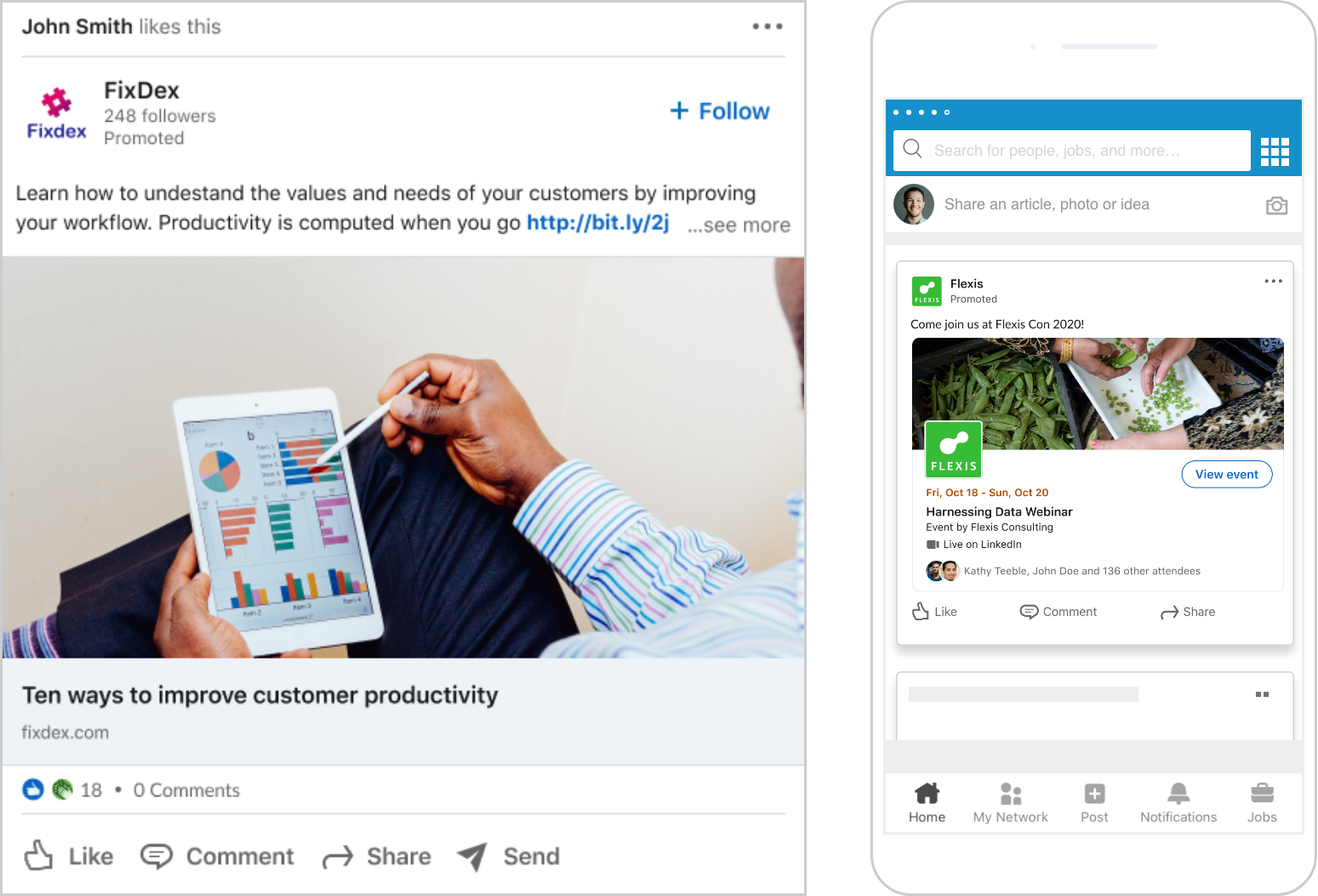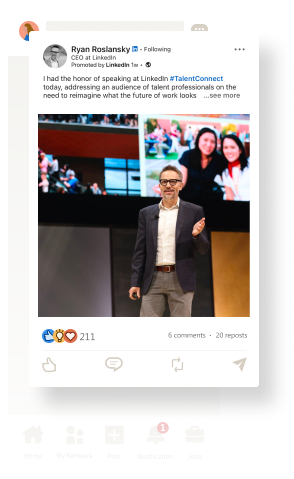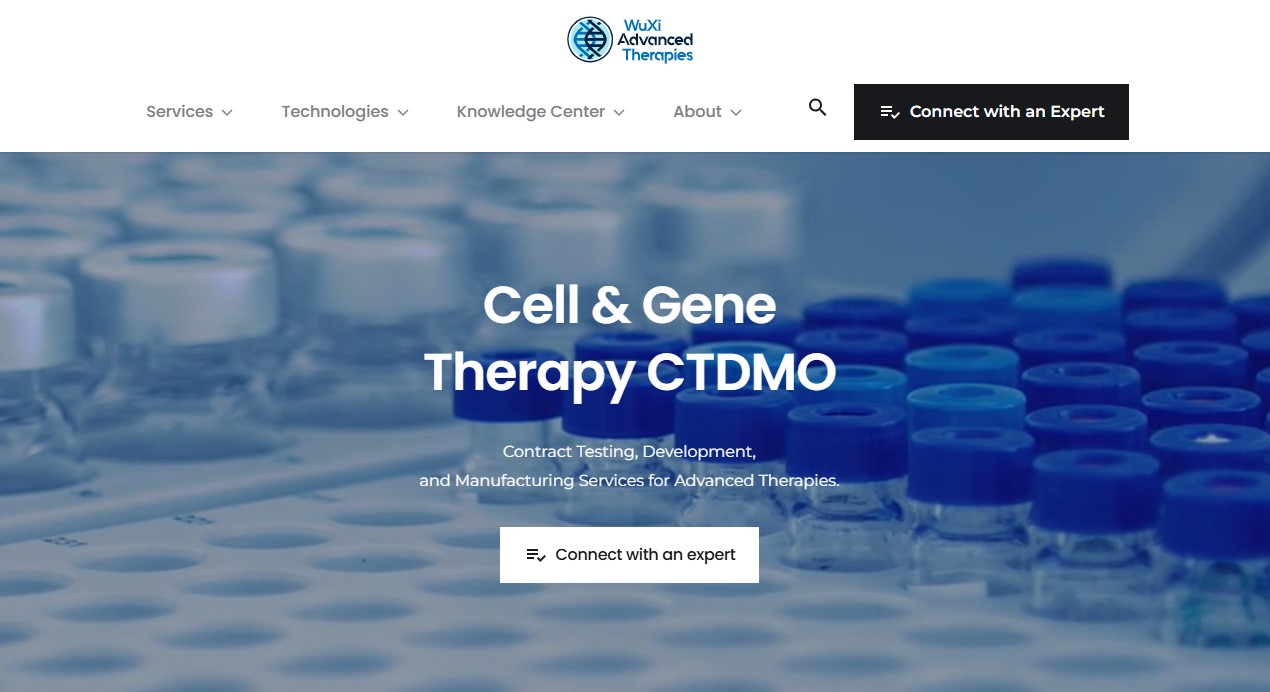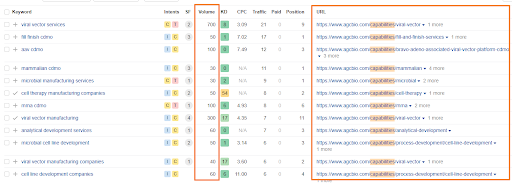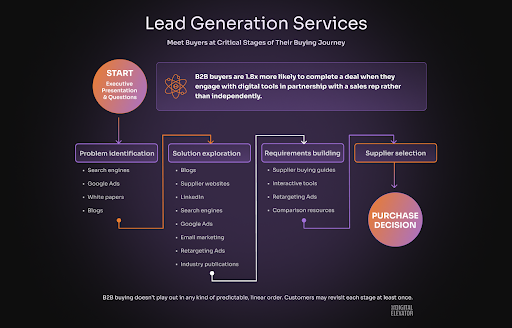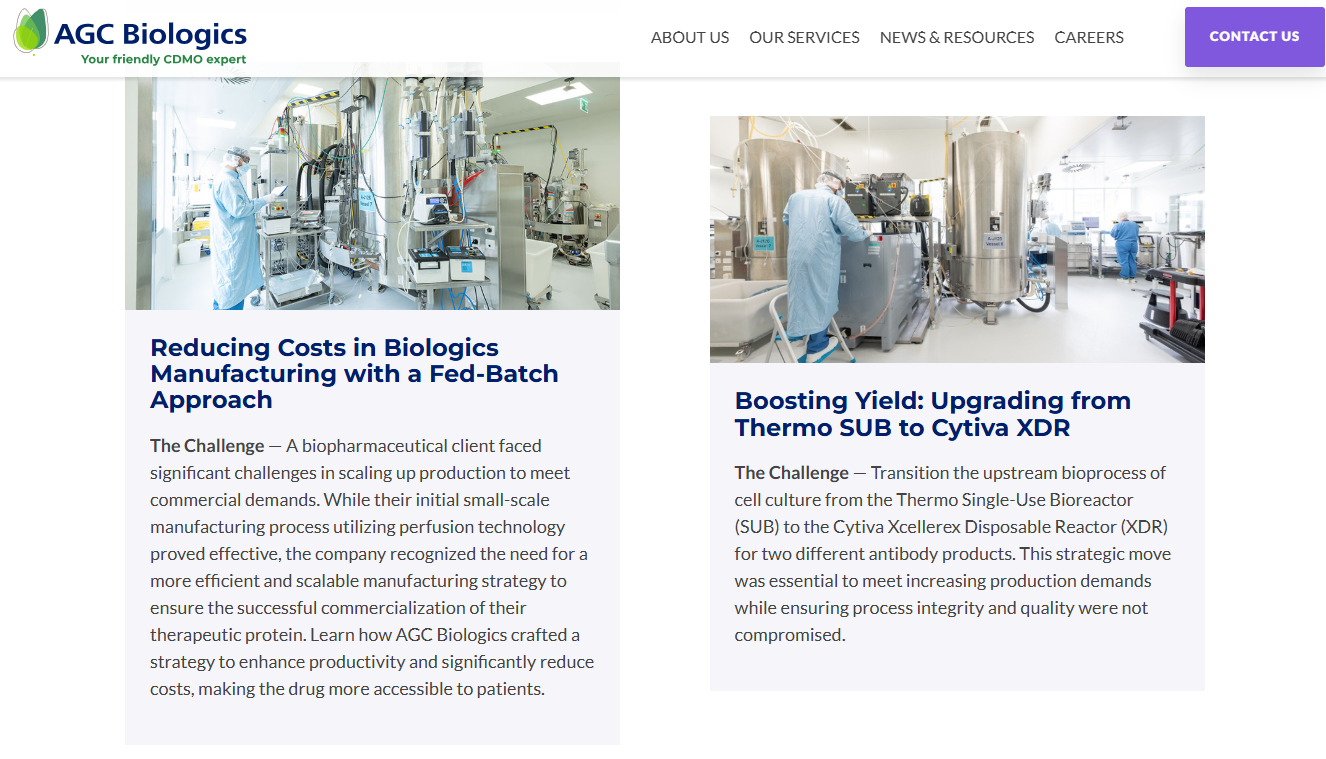The biotech industry is an extremely competitive landscape, with an estimated 9,022 companies across the various sectors and sub-sectors.
With so many players vying for attention, it is crucial for biotech companies to have a comprehensive marketing strategy in place that will help them stand out from the crowd as they seek favorability with clients, investors, potential partners, prospective employees, and, of course, the media.
In general, biotech companies can be split into three buckets of marketing, all of which can benefit from this guide.
- Emerging– Most emerging biotech companies have goals of raising capital, partnering, or commercializing their products, but tend to be in a pre-sales or revenue state.
- B2B– Established biotechs are primarily comprised of B2B companies selling to other biotechs.
- Pharma– B2C pharma companies with commercialized products selling primarily to consumers or vying for the attention of HCPs.
These companies tend to require different marketing strategies as they are catering to different audiences and buyer personas. More on that below.
Table of Contents
Foreword
As a veteran biotech commercial planning and commercial optimization contact once told me:
Every clinician thinks their product is the best, but the reality is that if the brand awareness and relationships that are made through marketing and PR aren’t there, emerging companies will face an uphill battle differentiating, meeting stakeholders, and forming strategic partnerships.
This guide aims to provide your company with a holistic understanding of marketing, from identifying its target audience to measuring your success. By following the advice provided, you can make smart decisions about marketing vendors, budgets, and brand exposure, ultimately helping you to gain a competitive edge in the industry.
The takeaways will be less about the actionable marketing initiatives you need to take and more about the marketing arenas you should consider planning for along with a marketing partner who has your best interests, and budget, in mind.

Understanding Your Audience
Understanding your audience is a crucial first step in developing a successful marketing strategy for biotech companies. This involves identifying your target audience, conducting market research to understand their needs and behaviors, and developing buyer personas.
Identifying target audience
The first step is to identify your target audience. As a scientist or CEO of an emerging biotech company, your audience may include investors, potential partners, researchers, clinicians, or even patients.
For B2B biotechs, you are likely gearing your marketing up to speak to the types of companies that purchase your products or services, as well as the job titles that you’ve identified are involved in this buying process.
By understanding who your audience is, you can tailor your marketing efforts to reach them effectively. For example, if your audience is investors, your marketing messages should focus on the potential return on investment and the commercial viability of your product.
Conducting market research
The next step is to conduct market research to understand your audience’s needs and behaviors. This involves analyzing data on their demographics, behavior patterns, and preferences. By doing so, you can gain insight into what motivates them to make decisions, what challenges they face, and how they prefer to consume information. This information can then be used to develop a targeted marketing campaign that speaks directly to your audience’s needs.
At Digital Elevator, we recommend that our B2B clients engage in a market research survey that helps our clients see how their prospective clients see them. For example, we have a case study that highlights how we helped an eCommerce biotech with the following:
- Gathered biotech decision-makers by title, seniority, industry, and company size and showed them the two landing pages on the existing website.
- With personalized questions, we were able to survey the client’s ideal customer profiles to get their feedback on the product and service pages, and how they felt about the offerings.
- We workshopped on these findings and updated the sales copy and page designs.
This market research had an immediate impact on sales and conversion rates and helped the client see how they were viewed from the eyes of their prospects.
Developing buyer personas
Finally, developing buyer personas can help you understand your audience on a more personal level. A buyer persona is a fictional representation of your ideal customer, based on research and data. By creating a detailed profile of your target audience, you can gain a better understanding of their motivations, pain points, and buying habits. This can help you tailor your marketing messages and create content that resonates with them on a personal level.
By identifying your target audience, conducting market research, and developing buyer personas, you can create targeted marketing campaigns that resonate with your audience, ultimately helping you to achieve your marketing goals. Once this is done, the marketing comes easier.
Get a free marketing proposal from our team today.
The discovery call is the first step in discussing your business, your goals, and the potential services you need for your marketing or web design campaign.
Biotech Marketing Focus Areas
The next steps are generally performed in the order presented, as this is the most logical way to carry out a marketing campaign. Some of these marketing initiatives may or may not apply to your biotech brand, you’ll have to determine the potential efficacy of each channel with your marketing team.
Logo & Branding
Building a strong brand identity is crucial for biotech companies looking to stand out in a competitive market. One of the first steps in creating a brand identity is designing a logo that accurately represents your company’s values and mission. A logo is a visual representation of your brand and serves as a key element in all of your marketing materials.
The process of creating a logo typically involves several steps. The first step is to develop a creative brief, which outlines the goals and objectives of the logo design. This brief should include information about your company’s values, mission, and target audience. From there, your vendor will typically present several logo design options for you to choose from, which can then be refined based on your feedback. Once a final design is chosen, the vendor will provide you with the necessary files and formats to ensure that the logo can be used effectively across all marketing channels.
In addition to a logo, a brand guide should also be developed at this stage. A brand guide is a comprehensive document that outlines your company’s brand identity and provides guidelines for its use. This includes information on your logo, color schemes, fonts, and other visual elements that should be used consistently across all marketing materials. By establishing these guidelines, you can ensure that your brand remains consistent and recognizable across all channels.
Creating a strong brand identity is essential for biotech companies looking to build trust with their target audience and stand out in a competitive market.
Biotech Logo & Branding Costs
Expect to pay anywhere between $5k to $10k for smaller agencies for this type of work and as much as $50k for larger agencies. If you are budget-conscious, consider sourcing talent on a site like 99designs.
Web Design
Having a strong web presence is crucial for biotech companies looking to establish themselves in the industry. In today’s digital age, a company’s website is often the first point of contact for potential clients, investors, partners, and employees. As such, it is important to ensure that your website accurately represents your brand and provides visitors with the information they need to make informed decisions.
As a leading biotech web design agency, we recommend different approaches depending on the type of company you are.
Emerging biotech website considerations
For smaller, emerging biotech companies, we recommend starting with a basic 5-10 page website that includes various sections on their leadership team, science, clinical trials, pipeline, press releases, and contact information.
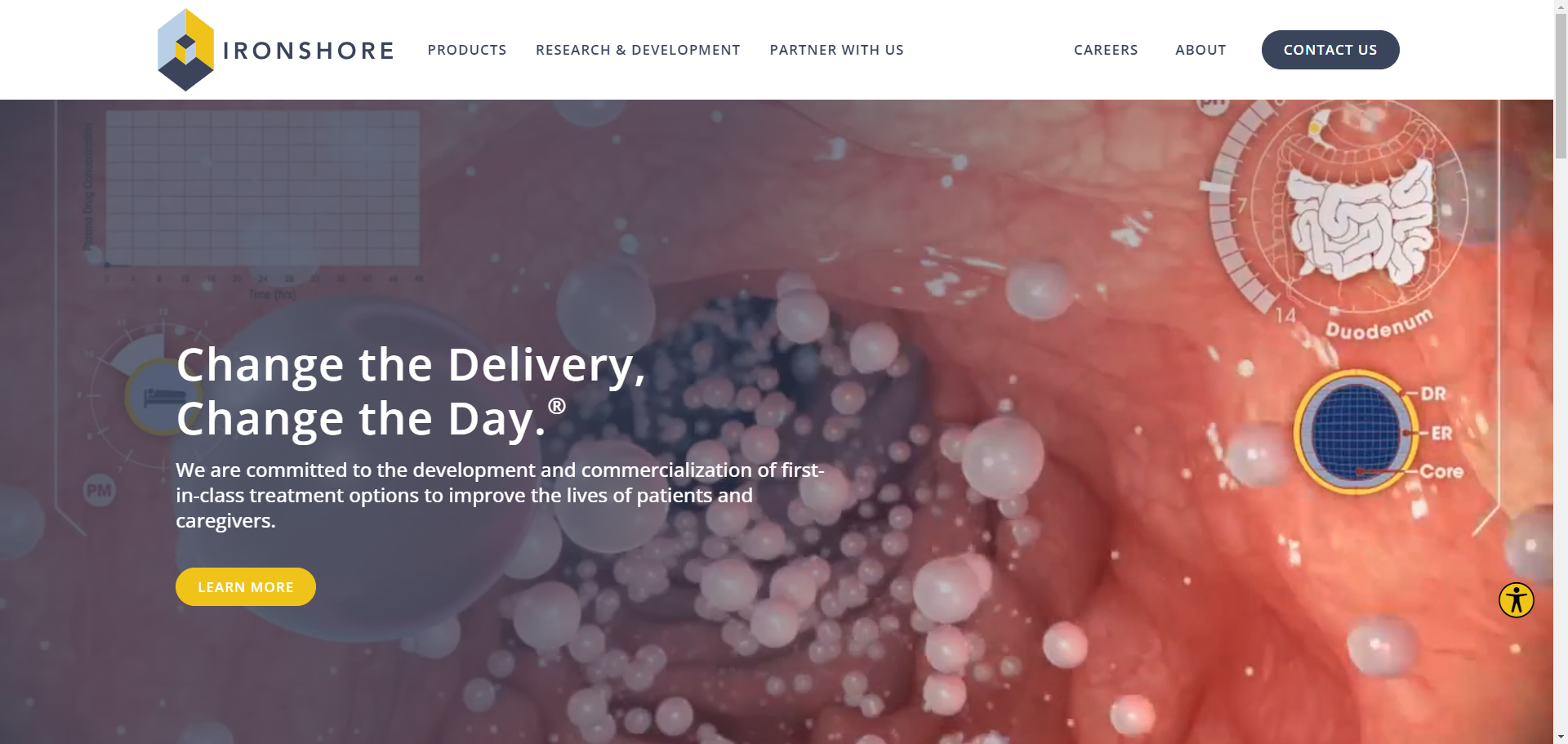
A life science hero image from Ironshore Pharma
These sections are essential for providing visitors with a comprehensive overview of your company’s activities and achievements. The leadership team section, for example, should include bios and photos of key executives, while the science section should provide an overview of your technology platform and any patents or intellectual property you may hold.
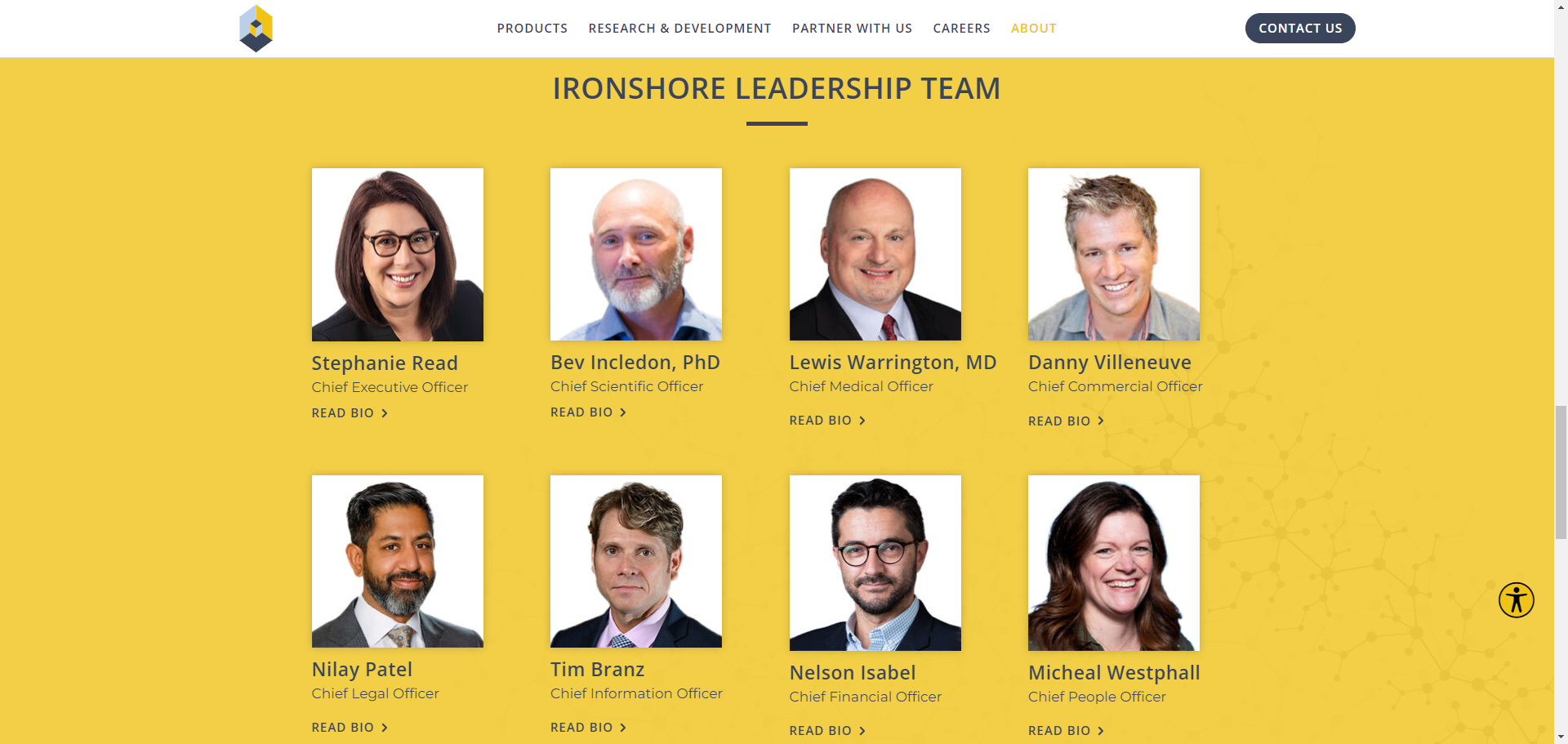
The Leadership section from Ironshore Pharma
Clinical trials and pipeline sections are also critical for demonstrating your company’s potential for success. These sections should provide detailed information on any ongoing or completed clinical trials, as well as an overview of your product pipeline and development timelines. Press releases are another important component of a biotech company’s website, as they showcase the company’s latest achievements and milestones.
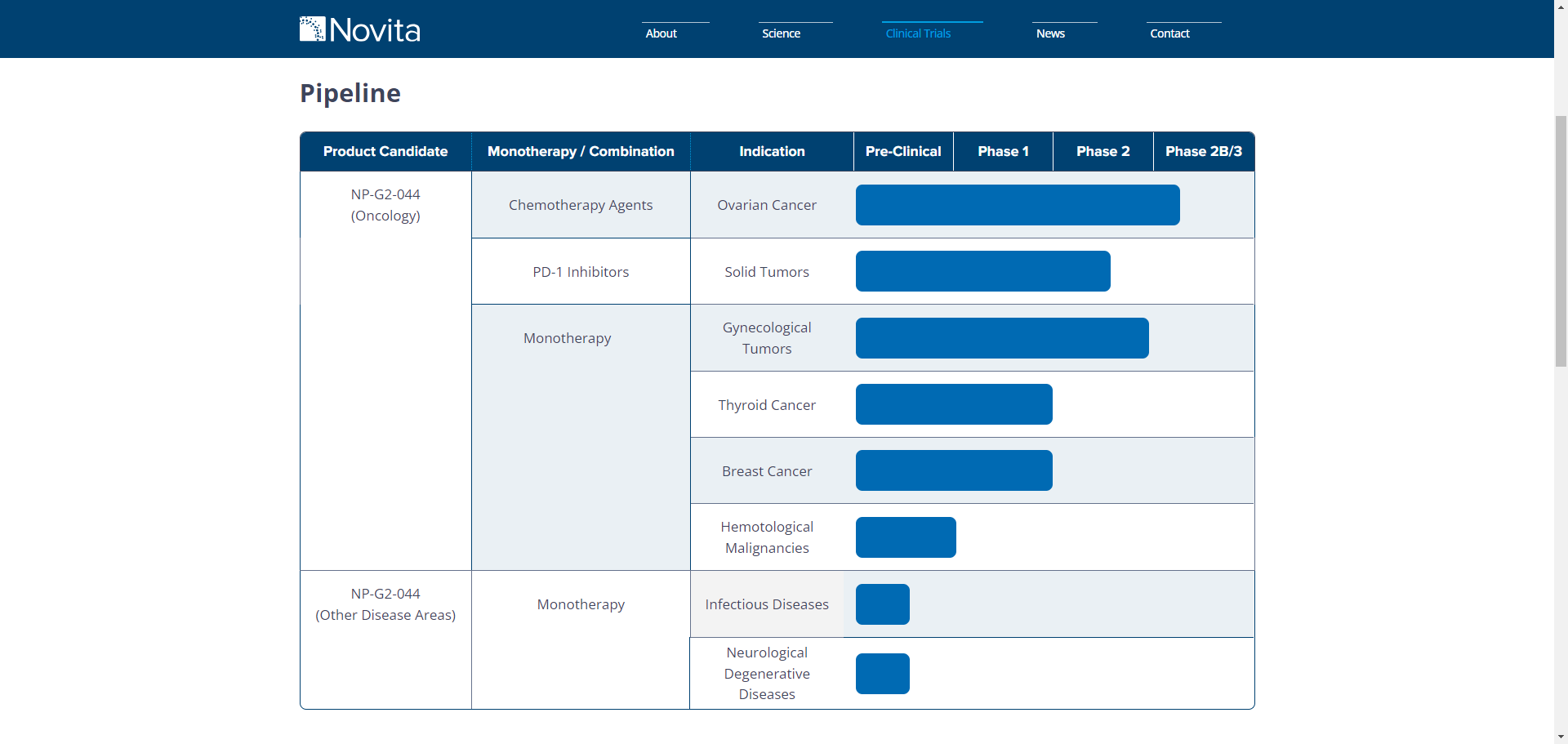
An example of a Pipeline page from Novita Pharma
Contact information is also an essential element of a biotech company’s website. This should include a phone number, email address, and physical address, as well as links to any social media profiles or other digital channels.
B2B biotech website considerations
For an established B2B biotech actively selling products, services, or via eCommerce, we recommend a much more comprehensive website strategy involving information architecture audits, UX/UI considerations, SEO, sales copy, and the continuation of a resource-rich website that helps educate prospects for what are normally long sales cycles.
Biotech Website Costs
For a professionally designed website built by an agency with experience in biotech, the prices can vary greatly. Specialized agencies who build simple, small websites are often found in the $15k to $25k range. For projects that require more planning and consideration into information architecture, UX/UI, and graphic design, expect projects to easily venture into the $40k to six-figure range depending on site size and integrations.
Note that the more complex the graphic design (ex. custom animation), integrations (CRM, ERP, eCommerce, etc.) the more expensive websites can get.
Graphic Design
For biotech companies of all sizes, graphic design is an essential tool for communicating complex scientific concepts to a broader audience, particularly those audiences who may need visual representations to quickly grasp your technology (which, let’s be honest, is everyone).
There are several elements of graphic design that are particularly important for you, including:
- data visualizations
- animations
- medical explainer videos
- infographics
- print adverts
- digital creatives
- presentations
- conference and booth creatives
- email content
- landing pages
Data visualizations are critical for biotech companies, as they enable the clear and concise presentation of complex scientific data. By transforming raw data into visual representations, such as charts, graphs, and diagrams, you can help to communicate your findings to a broader audience. Animations and medical explainer videos are also effective tools for illustrating complex scientific concepts, such as how a particular drug works in the body.
Infographics are another important element of graphic design for biotech companies. These visual representations can help to distill complex information into a more easily digestible format, allowing audiences to quickly grasp the key takeaways of a particular scientific study or concept. Print adverts and digital creatives, such as social media posts and banners, are also essential for promoting your products and services to a wider audience.
Presentations are an important part of the biotech industry, as they allow you to showcase your latest research and development efforts to potential investors and partners. Conference and booth creatives, such as banners, flyers, and other promotional materials, are also important for creating a strong brand presence at industry events. Email content and landing pages are also critical for biotech companies looking to engage with their target audience and convert leads into customers.
Biotech Graphic Design Costs
The costs of creative materials vary from company to company and can depend on factors such as whether you need an ongoing retainer or a la carte items. Each item can have significant cost differences as well. For example, a magazine graphic for print would be much more approachable than a medical explainer video. Expect to pay $175 an hour to as much as $400 an hour, depending on the agency and their background.

Public Relations
Public relations (PR) is a crucial element of marketing for emerging biotech companies. It is a must-have if you are looking to raise funds, partner with other companies, or get acquired. PR can help you to create a strong brand image, establish credibility, and gain exposure to potential investors, partners, and customers.
PR services for biotech companies can include:
- developing a public relations strategy
- message development
- media training
- media relationship management
- podcast interviews
- press release creation and submission
- content creation
- thought leadership outreach
- award submissions
- trade show pitching
- editorial calendars
- KPI measurement
Developing a biotech public relations strategy is the first step in creating a successful PR campaign. This involves defining your key messages, target audience, and goals for the campaign. Message development is also essential, as it ensures that all communications are consistent and aligned with your overall brand message.
Media training and relationship management are also critical for biotech companies, as they help to ensure that spokespeople are prepared and confident when engaging with the media. Podcast interviews can be an effective way to reach a targeted audience and showcase the company’s expertise in a particular area. Press release creation and submission are also essential for getting the word out about new products, partnerships, or research findings.
Content creation and thought leadership outreach can help you to establish yourself as an expert in your field and position yourself as a leader in the industry. Award submissions and trade show pitching can also help to increase visibility and credibility within the industry.
Editorial calendars and KPI measurements are important for tracking the success of a PR campaign and making adjustments as needed to ensure that it is meeting its goals.
While PR is not limited in effectiveness to emerging biotechs, this is what I’d call a must-have for companies looking to get some better exposure. PR for larger, more established brands is also important as brand awareness and the trust that inherently comes from being published in major industry publications cannot be overlooked.
Biotech PR Costs
Public relations costs will vary more than perhaps any marketing channel on this list. Depending on the prestige of the PR firm you hire, the relationships in place, and the number of hours spent getting your brand featured, the fees can vary greatly. For boutique PR firms, expect to pay $5,000 to $7,500 a month, depending on the inherent newsworthiness of your business. For large PR firms, expect to pay $15k to $20k per month. Learn more about the services at our biotech PR agency.
SEO & Content Marketing
SEO and content marketing are vital components of brand awareness and lead generation. A well-optimized website can drive traffic for relevant searches and content marketing such as blog posts can help familiarize your brand with informational topics where your company may provide solutions.
In general, our agency finds that blending SEO and SEO-driven content marketing — meaning all the content published is researched with keyword volume in mind — is the best use of resources.
SEO services for biotech companies might include:
- content strategy
- technical audits
- content audits
- keyword research
- competitive intelligence
- on-page SEO
- link building
- site architecture analysis
- user experience analysis
These services help to ensure that a company’s website is optimized for search engines and that it is providing value to its target audience.
Technical audits involve reviewing a website’s technical aspects, such as page load times, mobile responsiveness, and URL structure. Content audits involve assessing the quality and relevance of a website’s content and identifying areas for improvement. Keyword research helps to identify the keywords and phrases that are most relevant to the company’s target audience and that can help drive traffic to its website.
Competitive analysis involves analyzing the strategies and tactics of competitors in the industry and identifying areas where the company can differentiate itself. On-page SEO involves optimizing individual pages on the website for specific keywords and ensuring that they are properly structured for search engines. Link building involves acquiring high-quality backlinks to the website, which can help to improve its authority and visibility in search results.
Site architecture analysis and user experience analysis involve assessing the overall structure and usability of the website, including navigation, layout, and content organization. This helps to ensure that the website is easy to use and provides a positive experience for visitors.
Biotech SEO Costs
SEO and content marketing costs vary by agency. Digital Elevator, for example, focuses on SEO and content marketing initiatives that have business impact whereas other firms may sell you on the notion of running site audits and fixing technical issues. The impact of SEO and content marketing depends on the competitiveness of your topics, and the quality of work you need to outrank competitors. Expect to pay $6k to $8k a month for more streamlined SEO campaigns and as much as $10k+ a month for hyper-competitive content and outreach. You may also consider an AI SEO agency to help scale and automate content production without breaking the bank.
Paid Media or PPC
Paid media services are an effective way to drive traffic to your biotech company’s website or specific landing pages, but they also require careful consideration of regulatory restrictions.
Paid media services include:
- Google Ads
- programmatic ads
- CTV ads
- native ads
- display ads
- social media ads
It is important to adhere to industry regulations when advertising healthcare products or services, including adhering to FDA regulations on advertising, ensuring that claims are supported by clinical data, and avoiding unsubstantiated or false claims.
In addition, it is important to choose the appropriate channels and targeting options to reach the right audience while ensuring that the ads are compliant with industry regulations. A marketing agency can help navigate these complexities and ensure that your paid media efforts are compliant and effective.
Biotech Paid Media Costs
Paid media involves two costs: the cost of the actual ad spend, which goes directly to the ad platform, and the cost of management. While every product and campaign has different goals and target markets, there is a wide range of costs with paid media as it concerns the competitiveness of your products or services. For example, we’ve successfully run ads with a paid media budget of $3k a month, and have run other campaigns with budgets of 10x that amount. Most management fees will depend on the ad spend amount, with something like 15-25% of ad spend as an average fee, or flat fees, or flat fees plus a percentage of ad spend. Learn more about how agencies price PPC.
Social Media
Social media services can be an effective way for biotech companies to engage with their audience and raise awareness about their products and services. However, social media in the biotech industry can be challenging due to strict regulations around what can and cannot be shared publicly.
Social media services might include:
- social strategy development
- social calendar management
- user research
- social audits
- user persona research
- content guidelines
- branding guidelines
- social media ads.
Social strategy development involves creating a plan for how your company will use social media to achieve its goals. This includes identifying which platforms to use, how often to post, and what types of content to share.
Social calendar management involves scheduling and publishing content on social media platforms. This ensures that your company is consistently engaging with its audience and sharing relevant information.
User research involves understanding the needs and preferences of your company’s target audience. This information can be used to create content that resonates with the audience and drives engagement.
Social audits involve assessing your company’s current social media presence and identifying areas for improvement. This can include analyzing the content that is being shared, the engagement levels, and the overall effectiveness of the company’s social media efforts.
User persona research involves creating profiles of your company’s ideal customers. This information can be used to create content that is tailored to the specific needs and interests of the audience.
Content guidelines and branding guidelines help to ensure that the social media presence is consistent and aligned with its overall brand messaging. This includes guidelines around tone of voice, visual branding, and content topics.
Social media ads can be a powerful way for biotech companies to reach their target audience and promote their products or services. However, these ads must comply with strict regulations around advertising in the biotech industry.
Biotech Social Media Costs
Social media can be isolated into consulting or ongoing management. Consulting engagements can entail strategy or audits and can often cost $4k to $10k per project, sometimes more. For ongoing maintenance that includes creating content for clients, the monthly costs can be similar, however, the addition of video content on the agency side would greatly increase the monthly cost.
Budget Considerations for Biotech Brands
There are significant differences in cost between biotech marketing agencies like Digital Elevator and larger, well-known ad agencies, which can charge 2x to 5x as much as smaller agencies.
While these larger agencies may carry a certain prestige and brand recognition, the higher costs are often attributed to the agency’s size and reputation rather than the quality of work or expertise offered. It is worth noting that while these larger agencies may have an impressive portfolio and a long history of successful campaigns, clients may be paired with junior-level marketing representatives once they sign on.
On the other hand, smaller agencies like Digital Elevator may offer more personalized service, with experienced marketing professionals who are more invested in the success of their clients’ campaigns. These agencies can provide high-quality work at a lower cost, allowing emerging biotech companies to allocate their budgets more effectively while still achieving their marketing goals. Ultimately, choosing an agency comes down to balancing cost with the expertise and level of service provided.
Evolving Your Biotech’s Marketing With Your Company’s Evolution
As biotech companies progress through various stages, their marketing practices need to evolve. It’s important to recognize that not all biotech companies are speaking to the same audience at the same time. Some may be seeking patients for clinical trials, while others may be attracting investors or partners, and others trying to sell products or services to other biotech companies.
The key takeaway is that biotech companies need to improve their ability to identify target audiences and develop effective strategies to communicate with them through multi-channel marketing. Prioritizing marketing efforts alongside the science itself is crucial, as it can significantly contribute to the long-term success of the company.
Effective communication strategies are critical for success, and the right marketing partner can help. It’s essential to choose a marketing agency that understands the unique challenges and opportunities of the biotech industry and can provide tailored multi-channel marketing strategies that align with the company’s goals and target audience.
Overall, biotech companies need to be proactive in their marketing efforts, from creating a strong brand identity to developing a comprehensive marketing plan that includes public relations, content marketing, SEO, and social media. By doing so, they can effectively communicate their science and story to the right audiences and position themselves for success as they evolve over time.
Ready to Market Your Biotech?
If you are ready to share your science with the world and need a seasoned biotech marketing partner, contact Digital Elevator today to get a free analysis.
Get a free marketing proposal from our team today.
The discovery call is the first step in discussing your business, your goals, and the potential services you need for your marketing or web design campaign.



